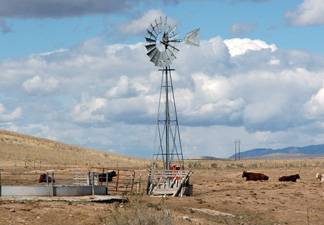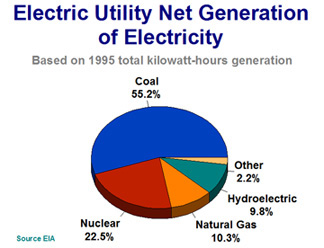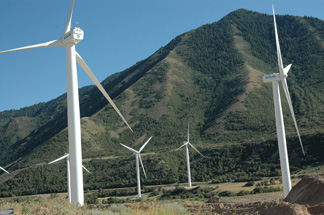Windmills
Using windmill technology in addressing the nation's energy crisis
LeRoy W. Hooton, Jr.
October 30, 2008
|
The windmill tail assembly orients the vanes into the wind to automatically adjust the direction of the windmill to catch the wind currents. The motion of the turning vanes is mechanically converted to a moving vertical pump plunger within the casing connected to the water aquifer. Double check valves located at both ends of the suction chamber, alternately close and open respectively during the downward and upward strokes drawing water out of the aquifer, which is then discharged into a small reservoir or containment. Winds between 5-10 miles per hour will operate the windmill. Between 1850 and 1970 over six million of these windmills were installed in the U.S.
Today, rather than pumping water, wind energy is turning turbines to generate electricity. The wind turbine is much larger than the mechanical water pump windmill with two or three propeller blades mounted on a substantially constructed tower at least 100 feet or higher where the wind is stronger and less turbulent. The shaft connected to the turning propellers rotates within the generator, producing electricity. Wind turbines require winds of 14 to 35 miles per hour in order to achieve the optimum efficiency.
If Texas oilman J. Boone Pickens has his way tens of thousands of wind turbines will be springing up across the nation generating clean renewable electrical energy. In recent months he has been seen on television ads drawing attention to the use of wind power to reduce American's energy reliance on foreign oil imports. Pickens proclaims, “In 1970, we imported 24 percent of our oil. Today it's nearly 70 percent and growing.” Pickens continues by warning, “... over the next 10 years it will be the greatest transfer of wealth in the history of mankind.” His plan proposes the use of wind power to replace the electricity now generated by natural gas and then shift the saved natural gas to replace gasoline currently used to fuel vehicles. By generating about 20 percent of the nation's electricity with wind energy and using U. S. natural gas for transportation, Pickens predicts a reduction of foreign oil imports by one-third.
Major investments in land, wind turbines and electrical transmission infrastructure will be necessary to accomplish the first part of Pickin's plan. In order to meet the second part of the plan, it will be necessary to manufacture natural gas vehicles and develop the infrastructure to make natural gas readily available to fuel them. Picken's plan does recognize it's going to take time to convert to new sources of energy. He describes his plan as “a bridge to the future.”
Pickens says that the Great Plain states of the U.S. contain the greatest potential for wind energy production found anywhere in the world. It is this region of the nation that he believes has the same wind energy potential as Saudi Arabia has in oil reserves. Picken's is investing some of his own wealth in tapping into some of that Great Plains wind. He is planning to build the largest wind farm in the world with 2,700 turbines generating 4,000-megawatts of electricity in west Texas (A megawatt is enough electricity to power 750 to 1,000 homes).
|
Utah's next door neighbor Wyoming is actively developing wind power in the eastern part of state with 288-megawatts of capacity. Just recently, a 185 mile transmission line was approved with a capacity to carry 850-megawatts of wind power electricity from Wyoming to the Colorado Front Range by 2015.
In Utah, according to National Wind Watch in 2007, only one megawatt of wind power had been developed. However, this past summer this number increased when 9 wind turbines with a generating capacity of 19-megawatts were put into operation at a wind farm located at the mouth of Span
|
Additionally, a recent news release announced a new 300-megawatt wind farm near Milford, Utah. The wind farm will occupy 40 square miles with 159 wind turbines standing 262 feet tall. The generated electricity will be conveyed via an 85-mile transmission line to an Intermountain Power substation in Delta, then delivered to southern California.
Utah's governor, Jon Huntsman, has set a goal to have Utah operating on 25 percent renewable energy by 2025.
What role does hydropower generation play in providing non-fossil renewable energy? Currently, approximately 10 percent of the nation's electricity is generated by hydropower. Although, hydropower has made a major contribution to the nation's energy supply, the potential for additional capacity is limited. The era of new large dams is over and small hydroelectric projects, for the most part, have not been economically feasible. The stigma associated with dams and hydropower further reduces the potential. However, there are still some opportunities for hydropower development, and it should not be discouraged in this time of energy crisis. This past summer the Central Utah Water Conservancy District completed the construction of a 12.91 megawatt hydroelectric plant at Jordanelle Dam, located west of Heber, Utah.
Existing hydropower generation provides millions of people low cost electricity. For example Hoover Dam, which is a major supplier to the southwest states, generates 2,078-megawatts of electricity. This capacity is equal to California's total wind energy capacity produced by 13,000 individual turbines.
As the nation tackles global warming and our dependence on foreign oil imports, there is enormous interest in wind power to replace fossil energy. Where water pump windmills now stand, wind driven turbines located across the vast lands of America may become the new beacons marking sites for clean energy generation.


